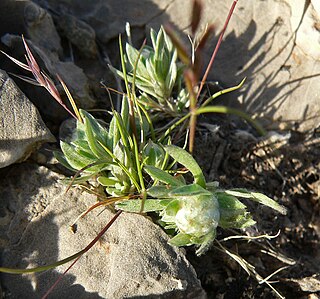
Stylocline(neststraw) is a small genus of North American desert plants in the tribe Gnaphalieae within the family Asteraceae.

Brickellia incana is a North American species of flowering plant in the family Asteraceae known by the common name woolly brickellbush. It is native to the Mojave Desert and Sonoran Desert in the southwestern United States, in California, Nevada, and Arizona.

Syntrichopappus is a genus of flowering plants in the family Asteraceae, found in the southwestern United States and northern Mexico, including Baja California. It is a member of the Heliantheae alliance of the Asteraceae family. There are two species. Common names include xerasid and Frémont's gold.

Psilocarphus brevissimus is a species of flowering plant in the family Asteraceae known by the common names short woollyheads, woolly marbles, and woolly heads.
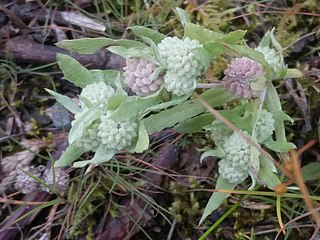
Psilocarphus elatior is a species of flowering plant in the family Asteraceae known by the common names tall woollyheads, meadow woollyheads and tall woolly-marbles. It is native to the Pacific Northwest in western North America from Vancouver Island, where it is known from just a few occurrences, to northern California. It grows in seasonally moist spots such as meadows, spring seeps, and vernal pools.

Psilocarphus tenellus is a species of flowering plant in the family Asteraceae known by the common names slender woollyheads and slender woolly marbles. It is native to western North America from far southwestern British Columbia to Baja California, where it grows in seasonally wet habitat, such as vernal pools, as well as coastline and disturbed areas.

Pyrrocoma apargioides is a species of flowering plant in the family Asteraceae known by the common name alpineflames. It is native to the western United States from the Sierra Nevada of California east to Utah, where it grows in the forests and meadows of high mountains. It is a perennial herb growing from a taproot and producing one or more stems to 30 centimeters in length. The stems are decumbent or upright, reddish, and hairless to slightly woolly. Most of the leaves are located around the base. They are thick and leathery, lance-shaped with large sawteeth along the edges, often center-striped in white, and measure up to 10 centimeters long. The inflorescence is usually a single flower head lined with centimeter-long phyllaries which are reddish to green with red edges. The head has a center of yellow disc florets and a fringe of ray florets which are yellow, often splashed with red along the undersides, measuring up to 1.6 centimeters in length. The fruit is an achene which may be well over a centimeter in length including its pappus.
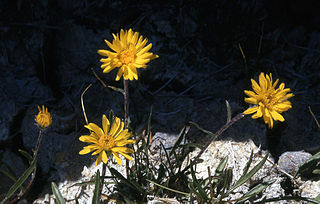
Pyrrocoma uniflora is a species of flowering plant in the family Asteraceae known by the common name plantain goldenweed. It is native to western North America from central Canada to California to Colorado, where it grows in several types of habitat, including forest and meadows with alkali soils, such as those near hot springs. It is a perennial herb growing up to 40 centimeters tall, the stems reddish and usually with a thin to thick coating of woolly fibers. The lance-shaped, toothed leaves are usually woolly, the largest near the base of the plant reaching up to 12 centimeters in length. The inflorescence is a single flower head or a cluster of a few heads, each lined with woolly phyllaries. The head contains yellow disc and ray florets. The fruit is an achene which may be over a centimeter long including its long pappus.

Ribes velutinum is a species of currant known by the common name desert gooseberry.

Scopulophila rixfordii is a species of flowering plant in the family Caryophyllaceae known by the common name Rixford's rockwort.
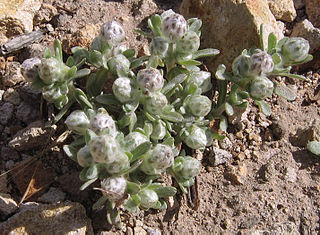
Stylocline gnaphaloides is a species of flowering plant in the aster family known by the common names mountain neststraw and everlasting neststraw.
Stylocline intertexta is a species of flowering plant in the family Asteraceae known by the common names Morefield's neststraw and Mojave neststraw. It is native to the Mojave and Sonoran Deserts of California, Nevada, Utah, and Arizona, where it grows in rocky, sandy desert soils. It likely evolved as a hybrid between woollyhead neststraw and baretwig neststraw ; it is a mix of their morphological traits and it occurs alongside both of them. It reproduces itself, producing fertile offspring, and it meets other criteria for any other definition of a species, so it was described to science as such in 1992. It is a small annual herb growing at ground level and reaching just a few centimeters in length. It is usually coated in white hairs, often woolly. The small, pointed leaves are oval to lance-shaped and measure up to 1.5 centimeters long. The inflorescence bears spherical flower heads each a few millimeters in diameter. The head has no phyllaries, just a ball of tiny woolly white flowers.
Stylocline masonii is an uncommon species of flowering plant in the family Asteraceae known by the common name Mason's neststraw.

Stylocline psilocarphoides is a species of flowering plant in the family Asteraceae known by the common names baretwig neststraw and Peck's neststraw. It is native to the western United States from Idaho to southeastern California, where it grows in deserts and other dry, sandy, gravelly habitat. It is a small annual herb growing at ground level with stems measuring 1 to 18 centimeters in length. It is woolly or felt-like in texture with a coating of white hairs. The pointed leaves are up to 1.8 centimeters long and alternately arranged. The inflorescence bears oval flower heads no more than half a centimeter in diameter. The head generally has no phyllaries, or has small ones that fall away early. It is a hardened ball of several woolly white flowers.

Tetradymia argyraea is a species of flowering plant in the aster family known by the common names striped cottonthorn and striped horsebrush. It is native to the desert mountains of the southwestern United States, particularly of California, Nevada, and Arizona, where it grows in desert woodland habitat. It is a woolly, spiny shrub growing one half to nearly two meters in maximum height. The erect stems are white-woolly except for bare stripes at intervals. The leaves are linear in shape and harden as they age, becoming spiny. The larger leaves are woolly and there are clusters of smaller, threadlike leaves which may be hairless. The inflorescence bears two to five flower heads which are each enveloped in five thick phyllaries coated in white woolly hairs. Each head contains five pale yellow flowers each around a centimeter long. Flowers are produced in summer, as late as September. The fruit is an achene a few millimeters long tipped with a pappus of bristles.
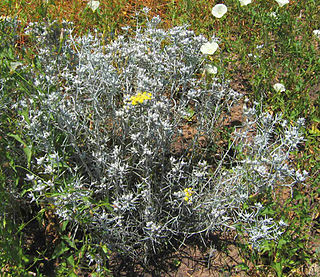
Tetradymia comosa is a species of flowering plant in the aster family, known by the common name hairy horsebrush.
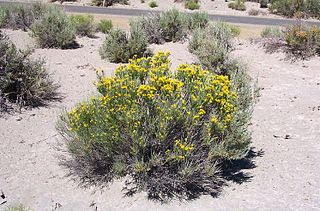
Tetradymia glabrata is a species of flowering plant in the aster family known by the common name littleleaf horsebrush. It is native to the western United States, especially the Great Basin and Mojave Desert. Its habitat includes sagebrush, woodlands, and scrub. It is an erect, bushy shrub growing to a maximum height over one meter, its stems coated unevenly in white woolly fibers with many bare strips. The narrow, pointed leaves are usually no more than a centimeter long and most occur in clusters along the branches. The inflorescence bears up to seven flower heads which are each enveloped in four woolly phyllaries. Each head contains four yellow cream flowers each around a centimeter long. The fruit is a hairy, ribbed achene with a pappus of bristles.

Tetradymia stenolepis is a species of flowering plant in the aster family known by the common name Mojave cottonthorn. It is native to the deserts around the intersection of Arizona, Nevada, and eastern California, where it grows in woodland and scrub habitat on sandy and gravelly substrates. It is a bushy shrub with many branches coated in woolly white fibers and growing to a maximum height just over a meter. The narrow leaves are 2 or 3 centimeters long and harden into straight, sharp spines. Clusters of woolly leaves grow near the spines. The inflorescence bears up to 7 flower heads which are each enveloped in four or five woolly phyllaries. Each head contains up to four or five tubular yellow flowers each around a centimeter long. The fruit is a hairy achene which may be nearly 2 centimeters long, including its pappus of long bristles.

Townsendia condensata is a species of flowering plant in the family Asteraceae known by the common names cushion Townsend daisy and cushion townsendia. It is native to North America where it is known from many scattered occurrences in the mountains of the western United States and Alberta in Canada. It is mainly limited to the alpine climates of high mountain peaks, where it grows in meadows, tundra, and barren, rocky talus. It grows alongside other alpine plants such as Eriogonum androsaceum.

Trifolium eriocephalum is a species of clover known by the common name woollyhead clover or hairy head clover.


















